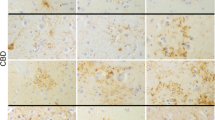Abstract
Argyrophilic grain disease (AgD), a frequent type of late onset dementia, is characterized by the occurrence of Gallyas-stained neuropil grains in the hippocampus, entorhinal cortex, amygdala and hypothalamus. High numbers of neurons containing hyperphosphorylated tau protein, but devoid of tangles, are encountered in areas rich in argyrophilic grains (ArGs). A third type of change consists of slender argyrophilic and tau-immunoreactive cytoplasmic inclusions in white matter oligodendrocytes, the coiled bodies. We now extend earlier studies on glial pathology in AgD (20 cases) and compare the results with glial changes in old age (10 cases) and Alzheimer’s disease (AD; 7 cases). Numerous non-argyrophilic, non-neuronal tau-positive stellate cells in the amygdala and anterior entorhinal cortex were consistently found in all of the 20 AgD cases but not in AD cases. Double-labelling experiments performed on paraffin sections with phosphorylation-dependent anti-tau antibody AT8, anti-glial fibrillary acidic protein and anti-CD44, revealed coexpression of these markers in stellate cells. The high expression of CD44 indicate that they probably correspond to reactive astrocytes. Unlike astrocytic plaques in corticobasal degeneration (CBD), where AT8 reactivity is accumulating in distal astrocytic processes, tau reactivity in AgD was found in all astrocytic cell compartments. The absence of glial fibrillary tangles further distinguished tau-labelled astrocytes in AgD from astrocytic plaques in CBD and tufted astrocytes in progressive supranuclear palsy (PSP). In contrast to AD and aged non-demented control cases tau-positive non-argyrophilic astrocytes represent a consistent finding in anterior limbic structures in AgD. Our findings point to a more widespread pathology of the glial cell population in AgD than previously supposed, and will be of further help in differentiating AgD from other neurodegenerative disorders, including AD, PSP, CBD and Pick’s disease.
Similar content being viewed by others
Author information
Authors and Affiliations
Additional information
Received: 2 November 1998 / Revised, accepted: 27 January 1999
Rights and permissions
About this article
Cite this article
Botez, G., Probst, A., Ipsen, S. et al. Astrocytes expressing hyperphosphorylated tau protein without glial fibrillary tangles in argyrophilic grain disease. Acta Neuropathol 98, 251–256 (1999). https://doi.org/10.1007/s004010051077
Issue Date:
DOI: https://doi.org/10.1007/s004010051077




